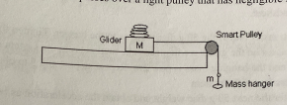Part a predictions number 1 draw free body diagrams and derive the equations for the acceleration of the system. How does the acceleration of the system depend on the hanging mass ?
Part a predictions number 1 draw free body diagrams and derive the equations for the acceleration of the system. How does the acceleration of the system depend on the hanging mass ?
College Physics
11th Edition
ISBN:9781305952300
Author:Raymond A. Serway, Chris Vuille
Publisher:Raymond A. Serway, Chris Vuille
Chapter1: Units, Trigonometry. And Vectors
Section: Chapter Questions
Problem 1CQ: Estimate the order of magnitude of the length, in meters, of each of the following; (a) a mouse, (b)...
Related questions
Question
Part a predictions number 1 draw free body diagrams and derive the equations for the acceleration of the system. How does the acceleration of the system depend on the hanging mass ?

Transcribed Image Text:and tra
Digital
of mass m, by a light string that passes over a light pulley that has negligible friction:
The two-body system shown below consists of a glider of mass M, attached to a hanger
LoggerPro with interface
Mass hanger
4-50 g disc weights
String
Background
Smart Pulley
Glider
M.
m
Mass hanger
The acceleration of this two-body system can be derived using Newton's 2nd Law, and
turns out to be
mg
a =
m + M
Or
hanging mass
a =
total mass
If the total mass (m + M) of the system is kept constant, the acceleration is directly
proportional to the hanging mass.
By transferring incremental weights from the glider cart to the hanger, we will vary the
nanging mass, while keeping the total mass of the system constant

Transcribed Image Text:A. Predictions
1. Draw free body diagrams, and derive the equation for the acceleration of the
system. How does the acceleration of the system depend on the hanging mass?
3.
Thet am The hangny mass
2. If the total mass of the system were constant, what would a graph of acceleration
'a' as a function of hanging mass look like? What
would its slope be?
Acceleration
Slope =
> Hanging mass
B. Data and Calculations
Mass of glider M =
1. Acceleration as a function of hanging mass
2. Excel Graph - Attach your printed graph to this sheet
Slope =
73
Expert Solution
Step 1
Given:

mass of glider = M
hanging mass = m
pully is frictionless and string is massless.
Trending now
This is a popular solution!
Step by step
Solved in 3 steps with 2 images

Knowledge Booster
Learn more about
Need a deep-dive on the concept behind this application? Look no further. Learn more about this topic, physics and related others by exploring similar questions and additional content below.Similar questions
Recommended textbooks for you

College Physics
Physics
ISBN:
9781305952300
Author:
Raymond A. Serway, Chris Vuille
Publisher:
Cengage Learning

University Physics (14th Edition)
Physics
ISBN:
9780133969290
Author:
Hugh D. Young, Roger A. Freedman
Publisher:
PEARSON

Introduction To Quantum Mechanics
Physics
ISBN:
9781107189638
Author:
Griffiths, David J., Schroeter, Darrell F.
Publisher:
Cambridge University Press

College Physics
Physics
ISBN:
9781305952300
Author:
Raymond A. Serway, Chris Vuille
Publisher:
Cengage Learning

University Physics (14th Edition)
Physics
ISBN:
9780133969290
Author:
Hugh D. Young, Roger A. Freedman
Publisher:
PEARSON

Introduction To Quantum Mechanics
Physics
ISBN:
9781107189638
Author:
Griffiths, David J., Schroeter, Darrell F.
Publisher:
Cambridge University Press

Physics for Scientists and Engineers
Physics
ISBN:
9781337553278
Author:
Raymond A. Serway, John W. Jewett
Publisher:
Cengage Learning

Lecture- Tutorials for Introductory Astronomy
Physics
ISBN:
9780321820464
Author:
Edward E. Prather, Tim P. Slater, Jeff P. Adams, Gina Brissenden
Publisher:
Addison-Wesley

College Physics: A Strategic Approach (4th Editio…
Physics
ISBN:
9780134609034
Author:
Randall D. Knight (Professor Emeritus), Brian Jones, Stuart Field
Publisher:
PEARSON